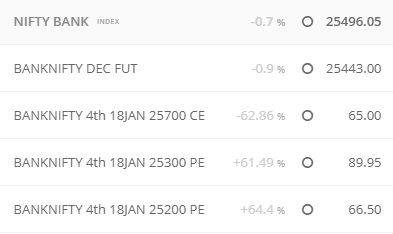Hey @adityaparakh
Sorry about joining the party late. Ill take a swing at your questions.
I will answer what seems to be the single biggest source of confusion
You have to use the futures price for equidistance. Because theoretically, the futures is the expectation of spot at the time of expiry!
If you are trading the month end option, put the underlying price as month end future price. And when you are using this in a pricing model, using r=0. Try it, seriously 
If you are trading weekly options, then you a weekly future price which does not exist. You can use the Put Call Parity formula on weekly options to arrive at this number
Equation reads C-P = D(F-K)
F = Future, K = Strike C= Call Price P= Put price
D= e^-rt where r = 6% (Repo Rate) t = 7/365 (this will be roughly equaly to one). 1.001 for 7 days
So C-P = F-K
So if 4th Jan 25500 Call = X
So if 4th Jan 25500 Put = Y
Actually what, do the math 
Wondering for intraday purpose - delta would be relevant or should look at premium amount and distance-to-strike.
Distance of future to strike.
(Although at a theoretical level, implied volatility does have a bearing on delta. But let’s not go there)
Where to get volatility?
NIFTY option chain. Although in weekly options, IV has hardly any meaning when its just three days to go because Vega (change in option price with change in vol) is very low.
Also, in weekly options, only ATM has any significant Vega.
IV makes sense for longer time options near the money.
How accurate is the IV auto calculated by the broker , specially as days to expiry become 1 or 2.
Not sure which broker 
Time to expiration in days. Say on Monday 12:00 noon , should I put 3 or 3.2 for Thursday 3:30 PM expiry
Doesn’t matter much. Like I said, if you are trading options it is much better to think in terms of “Not going above/ below this level” than thinking “Theta of x and Vega of Y”.
What about previous Friday ? 5 or 6 or 7 days.
6
Risk free rate. What about this ?
Repo Rate works. But there is an even better idea.
If you are trading the month end option, put the underlying price as month end future price and interest rate = 0. Try it. Seriously!
If you are trading weekly options, then you need to derive a meaningful value of a weekly future, had the weekly futures existed. We already figured how to do this in the beginning of the post
You will arrive at a theoretical future. Use that future price with r=0 in Black Scholes.
Secondly ,
Role of Price :
Does the option price play any role in being delta neutral?
Not really, Although, theoretically, yes. But you should ignore that. Look at distance of strike from future price.
I shouldn’t be averaging , based on price at different strikes right ?
IE : 2 qty at 75 is equal to 1 qty at 50 and 1 qty at 100.
Can I turn blind on the price ?
Not sure what this means
At equal strikes calls are substantially pricier than puts.
Role of distance from Strike
Being equal distance from Strike also doesnt mean being delta neutral right ?
say 200 points away for CE and PE - would not be delta neutral right ?
From observation : at equal distance from the strikes the Call is priced more.
Shouldn’t it be the PUT more expensice than Call.
It could be because you are using the spot instead of future,. Try using the future, / calculated weekly future, it should correct this.
The Risk free rate and time to expiry , dont seem to have a very major impact.
However , the IV does. and it changes very spontaneously.
Please advise , how price / strike / delta judgement - can be used to enter into 'as delta neutral" as possible.
Can I rely completely on the delta values from the Black Scholes Calculator to be direction indifferent.
As long as your inputs are right. The biggest catch here is getting the future right


